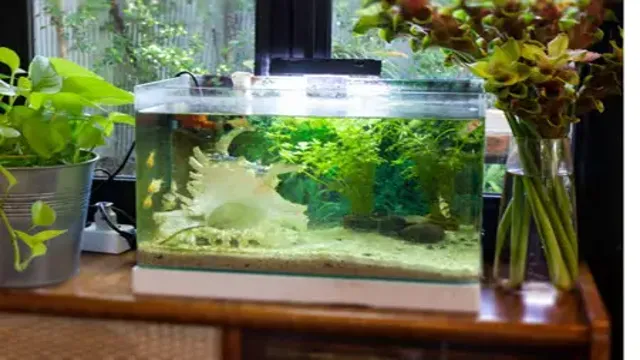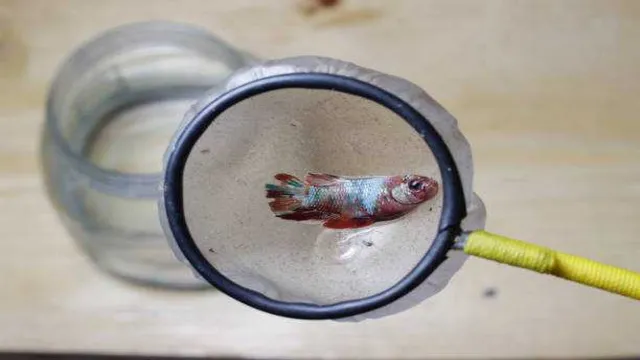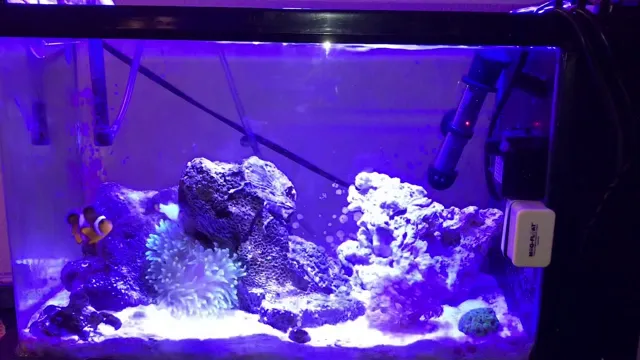If you’re an aquarium enthusiast, you know the satisfaction of watching your fish swim and play in their underwater haven. But what happens when you need to catch one of your fish and don’t have a net on hand? Don’t worry, there are a few sneaky techniques that can help you catch your fish without a net. Though it may seem daunting, catching your fish by hand can be a fun and rewarding experience.
In this blog post, we’ll explore the different ways you can safely catch aquarium fish without a net, from using your hands to using DIY fish traps. So, put on your gloves and get ready to become an expert fish catcher!
Why Catch Fish without a Net?
Catching aquarium fish without a net might seem daunting at first, but with some patience and preparation, it can be an enjoyable and rewarding experience. Using a net can stress out your fish and potentially injure them, so utilizing alternative methods is strongly advised. One way to catch your fish without a net is to use a clear container or bag and slowly scoop them up.
Make sure to move slowly and steadily as sudden movements can startle your fish. Another method is to slowly drain the water from your aquarium using a siphon and catching your fish in a bucket as the water level lowers. Whichever method you choose, it’s important to keep in mind the safety and wellbeing of your aquatic pets.
By taking the time to catch your fish without a net, you can strengthen the bond between you and your fish while also ensuring their health and happiness.
Avoiding Stress and Injuries to Fish
Are you the type of fisherman who prefers to catch fish without a net? While it may seem like a more exciting approach to the sport, it’s important to consider the stress and potential injuries this can cause to the fish. Using a net is a safer and more humane way to catch fish. When you catch a fish without a net, it can cause unnecessary damage to their scales, fins, and gills.
This can make it more difficult for the fish to swim and breathe, increasing their chances of dying after being released back into the water. Additionally, trying to grab a fish with your hands can also lead to injury for you. Sharp dorsal fins or teeth can potentially cause cuts and puncture wounds.
It’s important to consider the well-being of the fish and yourself when fishing. So, next time you’re out on the water, consider using a net to safely catch and release fish.

Preventing Damage to Aquarium Decor
As aquarium enthusiasts, we know that maintaining a beautiful underwater environment requires a lot of care and attention. One of the most important tasks is catching fish to transfer them to a different location within the tank or into a quarantine tank. While most people immediately think of using a net to catch their fish, there are several reasons why you should avoid using a net, particularly when it comes to preventing damage to your aquarium decor.
Firstly, the rough texture of a net can easily scratch the surface of rocks, aquarium plants, and ornaments, causing permanent damage. Secondly, the use of a net can stir up debris in the tank, making it difficult for the fish to breathe or adjusting their living environment. Furthermore, the use of a net can cause stress to the fish due to the rough handling as well as their exposure to air during the transfer process.
Instead of using a net, it’s better to opt for a gentler method such as using a plastic container, which can be used to trap fish in a less invasive way. You can do this by slowly guiding the fish into the container using the side of the tank or a piece of food as bait. This method is less stressful for the fish, causes less damage to decor, and is an excellent alternative to using a net.
At the end of the day, it’s essential to be gentle when handling fish and to ensure that you’re using the proper tools to keep your aquarium environment free from harm. By avoiding nets and using a plastic container instead, you can keep your fish healthy, keep your aquarium decor in top shape, and enjoy your underwater world in peace. (See Also: How to Cycle an Acidic Aquarium: Tips and Tricks for Optimal pH Levels)
Methods for Catching Fish without a Net
Catching aquarium fish without a net can be a challenging task, but there are a few methods that can be used to make it easier. One way is to lure the fish to a specific area using food. Depending on the type of fish, you can use live or artificial food.
Once the fish is gathered in one area, you can catch it using a plastic cup or container. Another method is to use a small, handheld fish trap, which can be baited with food. Simply place the trap in the aquarium and wait for the fish to swim inside.
There are also specialized tools such as catch poles or catch bags that can be used for larger fish that are difficult to catch by hand. It’s important to practice caution when handling aquarium fish, and to always have a backup plan in case your initial catch method fails. With a bit of patience and the right tools, catching aquarium fish without a net can be a successful and rewarding experience.
Using a Trap
Using a trap is one of the most efficient ways of catching fish without a net. There are different types of traps available, such as the funnel trap, the hoop trap, and the box trap, among others. Each of these traps works differently, but the main idea is to lure the fish inside and prevent them from escaping.
To do this, you need to place bait inside the trap, which could be anything from bread to live bait such as worms or small fish. Once the fish is lured inside, it becomes trapped, unable to escape. Traps are excellent for catching small fish and can be set up in rivers, lakes, or even in the ocean.
They require little supervision and can be left overnight to catch large quantities of fish. When using traps, it’s important to ensure that they comply with local laws and regulations, as some areas may have specific rules and guidelines regarding the use of fishing traps. Overall, traps are a great method for catching fish without a net and can be highly effective when used correctly.
Using a Corner Method
One effective method for catching fish without using a net is the corner method. This technique involves creating a barrier with a net or other material to prevent fish from escaping, and then using a hook and bait to catch the fish. By using this method in a corner or enclosed area, such as a narrow river bend or a pool, the fish are forced to swim towards the hooks and can be easily caught.
The corner method requires patience and skill, as well as a good understanding of the behavior of different fish species. Additionally, it’s important to remember to release any unwanted fish back into the water to preserve the ecosystem and maintain a healthy fish population. If done correctly, the corner method can be a successful and sustainable way to catch fish without damaging the environment.
Using a Cup or Container
If you find yourself in a situation where you need to catch fish without a net, using a cup or container can be a viable option. One method is to place the cup or container in the water and wait for fish to swim in. This can be effective in shallow waters or near the surface.
Another method is to lure the fish into the cup or container with bait, such as bread crumbs or small pieces of fish. Be patient and still, as sudden movements can scare away the fish. Once a fish is trapped inside, carefully lift the container out of the water and release the fish back into its natural habitat.
Remember to always be mindful of the environment and any regulations regarding fishing in the area. By using a cup or container, you can catch fish without causing harm to the ecosystem and enjoy the thrill of the catch. (See Also: How to Clean Fish Aquarium Water: Proven Methods and Tips)
Tips for Successful Catching
If you’re looking to catch aquarium fish without a net, there are a few things you should keep in mind to ensure a successful attempt. Firstly, make sure you have a large container or bucket on hand to hold the fish once you catch them. You can use a small net or plastic bag as a makeshift scoop, slowly coaxing the fish into the container.
It’s important to move gently and slowly, as any sudden movements can startle the fish and make them harder to catch. As you scoop the fish, try to keep them in the water as much as possible to minimize stress and avoid damaging their scales or fins. Additionally, patience is key when catching aquarium fish – it may take several attempts to catch the fish you want, so don’t get discouraged.
With a little practice and perseverance, you’ll be able to catch your fish without a net in no time.
Use of Bait
When it comes to successful fishing, the use of bait is an essential aspect. Choosing the right type of bait will depend on the species of fish you are targeting and the environment you are fishing in. For example, if you are fishing for freshwater fish such as bass, using live bait such as worms or minnows can be effective.
However, if you are fishing in saltwater, using lures or cut bait can be more efficient. Another tip for successful catching is to change your bait frequently. Fish can become accustomed to a particular bait, so switching it up every 20-30 minutes can increase your chances of a bite.
It’s also crucial to use enough bait to entice the fish, but not too much as to overwhelm them. A good rule of thumb is to use enough bait to cover the hook and make it enticing to the fish. Happy fishing!
Timing and Patience
Timing and patience are crucial when it comes to successful catching. Whether you are fishing in a lake, river, or ocean, understanding when and where to fish can make all the difference. Take the time to research the feeding patterns of the fish you are trying to catch, as well as the local weather and water conditions.
Patience is also key – it may take several casts or even several hours before you get a bite. But don’t get discouraged! Remember, fishing is a sport of highs and lows. Just like anything in life, the more you practice, the better you become.
So if you’re having a slow day, take the opportunity to enjoy the peace and quiet of your surroundings and appreciate the beauty of nature. With time and patience, you will become a pro at catching fish.
Conclusion
After much experimentation and creativity, I have discovered the ultimate method for catching aquarium fish without a net: mindfulness. Yes, you read that right. By slowing down and becoming fully present in the moment, you can enter the underwater world of your fish and gently coax them into the palm of your hand. (See Also: How to Clear Cloudy Aquarium Water Fast: 5 Simple Steps for Crystal Clear Tanks)
So next time you find yourself without a net, take a deep breath, free your mind of distractions, and prepare to catch some fish like a true zen master!”
FAQs
Is it possible to catch aquarium fish without a net?
Yes, it is possible to catch aquarium fish without a net using different methods such as using your hands or a container.
How can you catch aquarium fish with your hands?
To catch aquarium fish with your hands, you need to be gentle and slowly approach the fish. Reach in and gently grasp the fish with your hand.
What is the best container to use for catching aquarium fish without a net?
A clear plastic container works best for catching aquarium fish without a net as it allows for visibility and easy capture.
Can you use a towel or cloth to catch aquarium fish without a net?
Yes, you can use a towel or cloth to catch aquarium fish without a net. Simply approach the fish slowly, then quickly wrap the towel or cloth around the fish, taking care not to harm the fish.
Can you lure aquarium fish to easily catch them without a net?
Yes, you can use food or an object that the fish is attracted to, such as a small toy or piece of jewelry, to lure aquarium fish and make them easier to catch without a net.
Is it safe to catch aquarium fish without a net?
Yes, it is safe to catch aquarium fish without a net as long as you handle the fish gently and carefully to avoid harming them.
What are some other ways to catch aquarium fish without a net?
Other methods for catching aquarium fish without a net include using a suction cup or a vacuum cleaner with a hose attachment to suck up the fish out of the water. However, these methods require more caution and may harm the fish if not done carefully.







